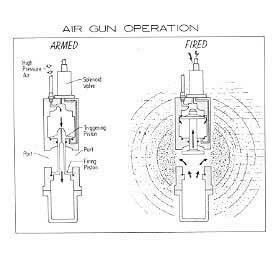Air Gun System
 |
Like the water gun, the air gun is also a pneumatic sound source. The system consists of an onboard air compressor and storage tanks, a shipboard electrical firing circuit controlled by a seismic recording system, and one or more air guns towed astern of the survey vehicle. The schematic above (derived from Bolt Associates, Inc., 1979) shows the arrangement of the basic components. On command from the seismic recording system, the air gun releases a specified volume of air into the water. The resulting release of air produces a steep-fronted shock wave followed by several oscillations resulting from the repeated collapse and expansion of the air bubble (bubble pulse).
Generated Injection Air Gun
The GI gun (pictured to the right) is configured to work in 'harmonic mode' which uses a primary chamber (generator) to produce a primary pulse, and the secondary chamber (injector) injects a second pulse near the maximum expansion of the primary pulse. This results in a dampening effect on the collapse of the primary bubble pulse. True ‘GI Mode’ is when the gun is configured as 105 cu. in. generator and 45 cu. in. injector. This is the optimal configuration for totally suppressing bubble oscillation, as the second pulse is injected into the primary pulse to prevent bubble collapse. Maximum power is obtained in the harmonic mode when both chambers are configured to be the same size and are fired simultaneously.
 |
| The GI gun suspended over the sea surface from the R/V Cape Hatteras, 1995. Air supply hoses are visible on the left side of the image. |
|---|
System Operation
The air gun requires an air compressor on board the ship. For maximum resolution, the smallest chamber size is used. If maximum penetration is the goal, a larger chamber is configured, but resolution is lessened. Both guns have a stable and repeatable pulse in terms of frequency composition and amplitude and can be tuned to optimize the source signature.Air guns generate more signal strength than boomer, and sparker, and chirp systems. The air gun is towed astern. The return signals are received by a towed hydrophone array.
System Usage
The air guns are relatively deep penetration sources, operating at 100 to about 1200 Hz, to identify subsurfacegeologic layers and define the subsurface structure. In studies that require less resolution but substantial penetration, the air gun is usually preferable as compared to a water gun, because it is far more efficient at producing low frequency energy. It can be used in fresh or brackish (less saline) water found in lacustrine and estuarine environments. Both air guns (and water guns) can be used in shallow water surveys and relatively deeper water environments, achieving resolution on the order of 10 to 15 meters and up to 2000 meters penetration. With proper tuning, the air guns work well in a wide variety of bottom types. Minimum operating water depths of about 10 meters are possible in acoustically “soft” bottoms. In areas with acoustically hard bottoms, deeper water depths of operation are required. The harder bottoms produce multiples, unwanted reflective energy that travels repeatedly between the sea surface and the sea floor or shallow-subsurface and obscures the desired primary reflected energy arrivals. The Sea Floor Mapping Group uses the GI gun almost exclusively now, due to its bubble-suppression capabilities.
Below are examples of profiles from the northern Gulf of Mexico, Keathley Canyon, shot during a cruise aboard the R/V Gyre to investigate gas hydrates. The line on the left was shot with the GI gun configured with 13 cu. in. generator and 13 cu. in. injector chambers with 20 –m shot spacing. The middle line, shot over the same location, was shot with the GI gun configured with 24 cu. in. generator and 24 cu. in. injector chamber and a 30-m shot spacing. In this location there is little difference between the two. The deeper reflections are somewhat stronger in the section shot with the 24/24 configuration. The section was also shot with a 15-cu. in. water gun for comparison. In this location, with a muddy sea floor at mid-slope (~1300 m) water depths, the GI gun had better signal-to-noise characteristics, penetration at depth was better, and the quality of the reflections were better at almost all depths (Hutchinson and Hart, 2003).
 |
| Example of migrated multichannel seismic section from Keathley Canyon, Gulf of Mexico. CDP's are 5m apart. Vertical scale is in seconds two-way travel time. |
|---|
References
Bolt Associates, Inc., 1979, PAR Air Gun, Bolt Associates Inc. Technical Brochure (now known as Bolt Technology Corporation).
Hart, P.E., Hutchinson, D.R., and M.W. Lee, 2005, High-resolution multichannel seismic-reflection data acquired in the northern Gulf of Mexico, 2003, USGS Open File Report 2005-1411.
Hutchinson, D.R., and P.E. Hart, 2003, Cruise Report for G1-03-GM, USGS Gas Hydrates cruise, R/V Gyre, 1-14 May 2003, Northern Gulf of Mexico, USGS Open File Report 03-474.











